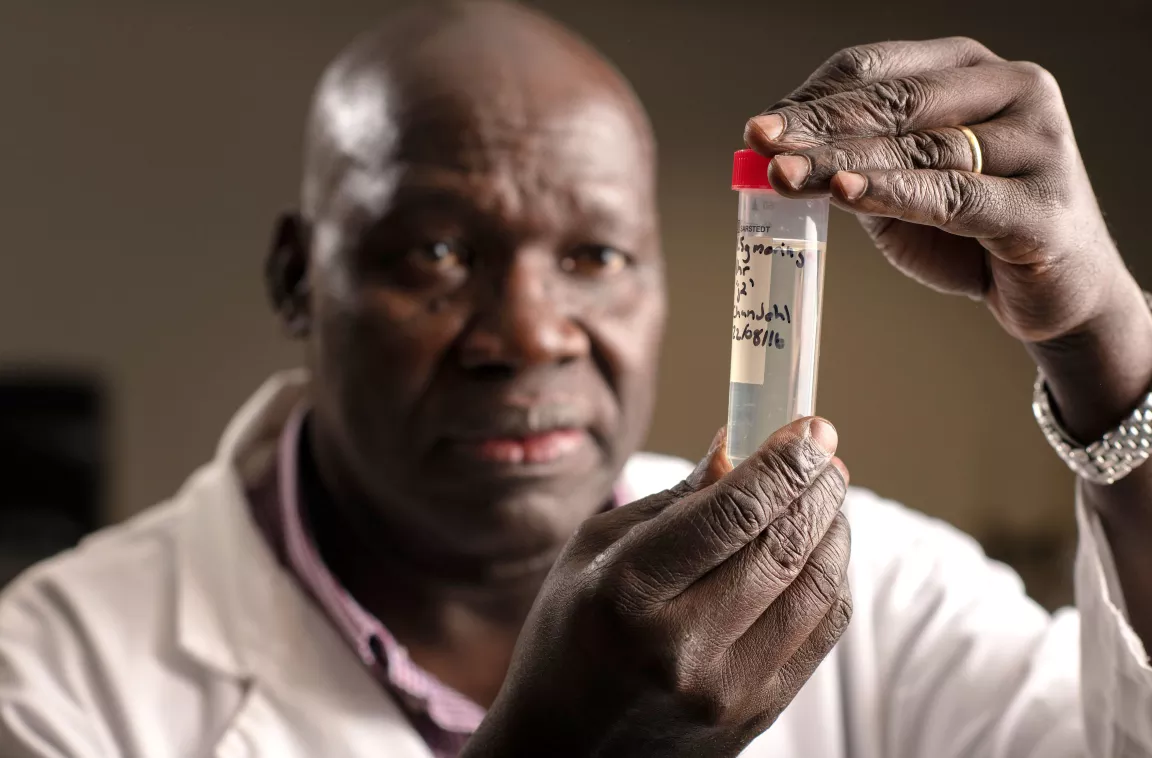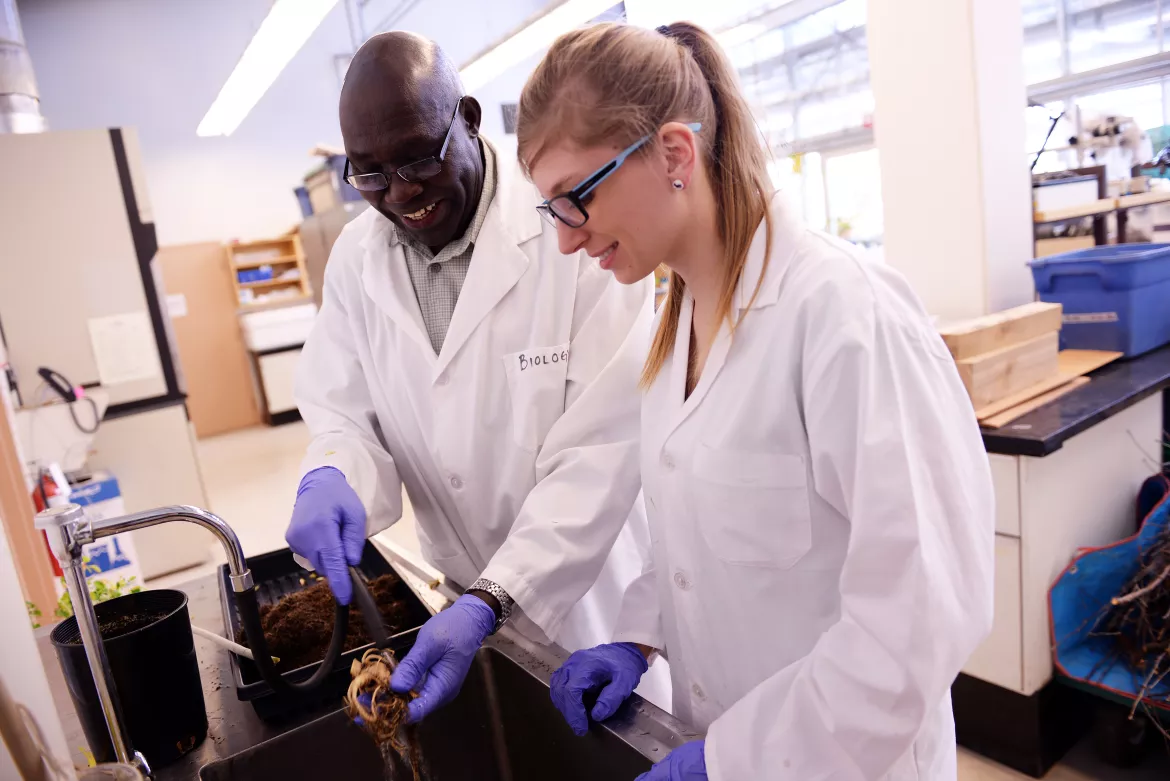Rooting for Clean Water
Moringa tree root powder has potential as a water treatment solution

One by one, Dr. Chris Opio and Chandehl Morgan carefully remove trees from one-gallon buckets.
The Moringa trees, reaching heights of 1.11 metres, have been growing in pots of well-drained soil for seven months in the I. K. Barber Enhanced Forestry Lab at UNBC’s Prince George campus.
Opio, an Ecosystem Science and Management Professor, and Morgan, a graduate student, gently brush the soil from the roots, cut them from the trunk of the trees and wash them in a stainless-steel sink.
The researchers peel the root bark and put them in a 70C oven to dry. Once dry, the roots are ground into a fine powder.
It’s tedious work, but it’s the valuable root powder they’re after.
Opio and Morgan want to determine whether the Moringa roots can purify water by reducing the bacteria and turbidity, or cloudiness.
The Moringa oleifera tree is native to Northern India, but common in the tropical and sub-tropical regions of Asia, Africa, and Latin America.
Known as a miracle tree, it gets its moniker from the many uses of all its parts. It’s antimicrobial, anti-inflammatory and nutritious, and has been used to treat typhoid and fecal coliforms in water, while also serving a role in many traditional medicines.
After two years of careful exploratory research and study, Opio and Morgan have discovered that the Moringa tree root powder can kill most E. coli bacteria, up to 87 per cent, in contaminated water.
The initial results mean that Moringa root powder has the potential to be used as a point-of-use water treatment, said Morgan. Further research will be needed, both to optimize the method and test treated water’s palatability.
It’s an important finding that could have significant national and global impacts. A water treatment solution, once optimized and approved, could be developed for use in at-risk communities, such as rural First Nations in Northern B.C. and across Canada that do not have access to traditional water treatment, and where their remote location makes installing traditional systems difficult and expensive.

It could further be applied in developing countries, or as a response during emergency situations, says Opio.
“The global impact of addressing the issue of contaminated water with Moringa root powder will have started with research here, conducted at UNBC,” Opio explains. “UNBC facilities and resources went into every part of this project, from growing trees to analyzing bacteria in water. It wouldn’t have been possible without our local research facilities.”
The Moringa trees were grown in the Enhanced Forestry Lab by John Orlowsky and Doug Thompson, while data was collected in the Northern Analytical Laboratory Service with the help of Dr. Hossein Kazemian, Erwin Rehl, Lon Kerr and Charles Bradshaw.
Funding for the research came from the Northern Uganda Development Fund’s Special Fund, a UNBC research grant, Dr. Opio’s professional development fund and a research grant from Dr. Saphida Migabo.
Lack of access to safe drinking water is a significant issue; the United Nations and World Health Organization reports that 663 million people live without access to safe water.
Lack of access to clean water and sanitation conditions results in the spread of diseases and the death of more than 840,000 people each year. Waterborne diseases disproportionately affect those in marginalized societies.
For Morgan, the opportunity to conduct cutting-edge research on such a vital topic as water security was exciting and rewarding.
“Exploring properties of Moringa roots that had never been tested before meant I had the chance to develop new methods and discover something that is not only scientifically exciting, but also has the potential to help people in a very practical way,” she said.
“Access to clean water is so important; it’s a great privilege to research this water treatment method.”
Before the exploratory research can be proposed as a water treatment, more tests need to be done. While Morgan and Opio were able to kill 87 per cent of the E. coli in the water, they want to see that number reach 100 per cent. Moringa production companies in the U.S. and Uganda are interested in the research and the potential application and collaboration the future may hold.
Research into using Moringa tree root powder as an effective point-of-use water treatment began in April 2016 at UNBC.
The tests revealed that the water treated with the roots had an acceptable pH and electrical conductivity.
The root powder did not have a significant impact on the turbidity, or cloudiness, of water.
Some of the methods used to determine if the root powder could kill E. coli bacteria include the following.
- Once in its powder form, the Moringa roots were tested in the Northern Analytical Laboratory Service on campus to determine its chemical components.
- The Moringa roots are high in five macronutrients: potassium, phosphorus, magnesium, sodium and calcium.
- Water that had powdered Moringa root added to it was also tested to determine what elements the roots released into the water. It was compared both with the Canadian guidelines for drinking water quality, and with the elements present in milk.
- Using water contaminated with E. coli bacteria collected from a pond on a farm north of Prince George, Opio and Morgan developed methods to test if the Moringa has any impact of bacteria in water.
- The root powder was dissolved in clean, distilled water to create a Moringa root solution. The solution, in various concentrations, was added to the contaminated water to see if it had any impact on purifying the water.
- The beakers sat for one hour, then several parameters of water quality were tested including acidity (pH), electrical conductivity, turbidity (or cloudiness), and presence of bacteria.